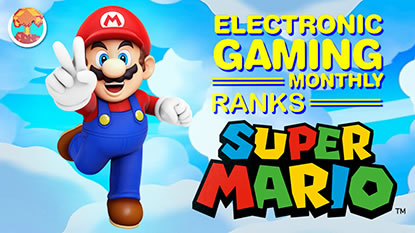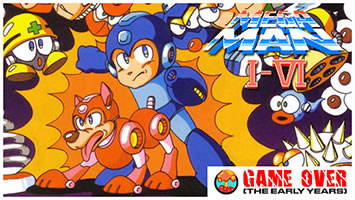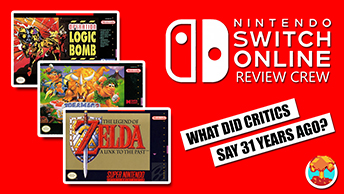- CLASSIC MAGAZINES
- REVIEW CREW
A show recapping what critics thought back
when classic games first came out! - NEXT GENERATION'S BEST & WORST
From the worst 1-star reviews to the best
5-stars can offer, this is Next Generation! - NINTENDO POWER (ARCHIVE)
Experience a variety of shows looking at the
often baffling history of Nintendo Power! - MAGAZINE RETROSPECTIVE
We're looking at the absolutely true history of
some of the most iconic game magazines ever! - SUPER PLAY'S TOP 600
The longest and most ambitious Super NES
countdown on the internet! - THEY SAID WHAT?
Debunking predictions and gossip found
in classic video game magazines! - NEXT GENERATION UNCOVERED
Cyril is back in this spin-off series, featuring the
cover critic review the art of Next Generation! - HARDCORE GAMER MAGAZING (PDF ISSUES)
Download all 36 issues of Hardcore Gamer
Magazine and relive the fun in PDF form!
- REVIEW CREW
- ELECTRONIC GAMING MONTHLY
- ELECTRONIC GAMING MONTHLY RANKS
From Mario to Sonic to Street Fighter, EGM
ranks classic game franchises and consoles! - ELECTRONIC GAMING MONTHLY BEST & WORST
Counting down EGM’s best and worst reviews
going year by year, from 1989 – 2009! - ELECTRONIC GAMING BEST & WORST AWARDS
11-part video series chronicling the ups and
downs of EGM’s Best & Worst Awards!
- ELECTRONIC GAMING MONTHLY RANKS
- GAME HISTORY
- GAME OVER: STORY BREAKDOWNS
Long-running series breaking down game
stories and analyzing their endings! - A BRIEF HISTORY OF GAMING w/ [NAME HERE]
Real history presented in a fun and pithy
format from a variety of game historians! - THE BLACK SHEEP
A series looking back at the black sheep
entries in popular game franchises! - INSTANT EXPERT
Everything you could possibly want to know
about a wide variety of gaming topics! - FREEZE FRAME
When something familiar happens in the games
industry, we're there to take a picture! - I'VE GOT YOUR NUMBER
Learn real video game history through a series
of number-themed episodes, starting at zero! - GREAT MOMENTS IN BAD ACTING
A joyous celebration of some of gaming's
absolute worst voice acting!
- GAME OVER: STORY BREAKDOWNS
- POPULAR SHOWS
- DG NEWS w/ LORNE RISELEY
Newsman Lorne Riseley hosts a regular
series looking at the hottest gaming news! - REVIEW REWIND
Cyril replays a game he reviewed 10+ years
ago to see if he got it right or wrong! - ON-RUNNING FEUDS
Defunct Games' longest-running show, with
editorials, observations and other fun oddities! - DEFUNCT GAMES QUIZ (ARCHIVE)
From online quizzes to game shows, we're
putting your video game knowledge to the test!- QUIZ: ONLINE PASS
Take a weekly quiz to see how well you know
the news and current gaming events! - QUIZ: KNOW THE GAME
One-on-one quiz show where contestants
find out if they actually know classic games! - QUIZ: THE LEADERBOARD
Can you guess the game based on the classic
review? Find out with The Leaderboard!
- QUIZ: ONLINE PASS
- DEFUNCT GAMES VS.
Cyril and the Defunct Games staff isn't afraid
to choose their favorite games and more! - CYRIL READS WORLDS OF POWER
Defunct Games recreates classic game
novelizations through the audio book format!
- DG NEWS w/ LORNE RISELEY
- COMEDY
- GAME EXPECTANCY
How long will your favorite hero live? We crunch
the numbers in this series about dying! - VIDEO GAME ADVICE
Famous game characters answer real personal
advice questions with a humorous slant! - FAKE GAMES: GUERILLA SCRAPBOOK
A long-running series about fake games and
the people who love them (covers included)! - WORST GAME EVER
A contest that attempts to create the worst
video game ever made, complete with covers! - LEVEL 1 STORIES
Literature based on the first stages of some
of your favorite classic video games! - THE COVER CRITIC
One of Defunct Games' earliest shows, Cover
Critic digs up some of the worst box art ever! - COMMERCIAL BREAK
Take a trip through some of the best and
worst video game advertisements of all time! - COMIC BOOK MODS
You've never seen comics like this before.
A curious mix of rewritten video game comics!
- GAME EXPECTANCY
- SERIES ARCHIVE
- NINTENDO SWITCH ONLINE ARCHIVE
A regularly-updated list of every Nintendo
Switch Online release, plus links to review! - PLAYSTATION PLUS CLASSIC ARCHIVE
A comprehensive list of every PlayStation
Plus classic release, including links! - RETRO-BIT PUBLISHING ARCHIVE
A regularly-updated list of every Retro-Bit
game released! - REVIEW MARATHONS w/ ADAM WALLACE
Join critic Adam Wallace as he takes us on a
classic review marathon with different themes!- DEFUNCT GAMES GOLF CLUB
Adam Wallace takes to the links to slice his way
through 72 classic golf game reviews! - 007 IN PIXELS
Adam Wallace takes on the world's greatest spy
as he reviews 15 weeks of James Bond games! - A SALUTE TO VAMPIRES
Adam Wallace is sinking his teeth into a series
covering Castlevania, BloodRayne and more! - CAPCOM'S CURSE
Adam Wallace is celebrating 13 days of Halloween
with a line-up of Capcom's scariest games! - THE FALL OF SUPERMAN
Adam Wallace is a man of steel for playing
some of the absolute worst Superman games! - THE 31 GAMES OF HALLOWEEN
Adam Wallace spends every day of October afraid
as he reviews some of the scariest games ever! - 12 WEEKS OF STAR TREK
Adam Wallace boldly goes where no critic has
gone before in this Star Trek marathon!
- DEFUNCT GAMES GOLF CLUB
- DAYS OF CHRISTMAS (ARCHIVE)
Annual holiday series with themed-episodes
that date all the way back to 2001!- 2015: 30 Ridiculous Retro Rumors
- 2014: 29 Magazines of Christmas
- 2013: 29 Questionable Power-Ups of Christmas
- 2012: 34 Theme Songs of Christmas
- 2011: 32 Game Endings of Christmas
- 2010: 31 Bonus Levels of Christmas
- 2009: 30 Genres of Christmas
- 2008: 29 Controls of Christmas
- 2007: 34 Cliches of Christmas
- 2006: 33 Consoles of Christmas
- 2005: 32 Articles of Christmas
- 2004: 31 Websites of Christmas
- 2003: 29 Issues of Christmas
- 2002: 28 Years of Christmas
- 2001: 33 Days of Christmas
- NINTENDO SWITCH ONLINE ARCHIVE
- REVIEW ARCHIVE
- FULL ARCHIVE
You Missed Your Opportunity, Midway

In an interesting side note, this is simultaneously the most and least appropriate picture for this article!
Something has seriously gone awry at Midway. You would think that a company with so many amazing arcade releases wouldn't have any trouble making some easy cash. But that's just not the case for Midway. The problem is simple: Midway only tried ideas once or twice before giving up. Instead of nurturing the genres and putting money towards sequels, Midway decided to ignore many of their most promising games.
In this article we attempt to prove once and for all that Midway missed important opportunities at least seven different times. And it's not just Midway, we're also going to lump in the Atari-developed games that Midway currently owns. You'll be surprised at the number of terrible decisions Midway made as they spiraled further into bankruptcy. You missed your opportunity, Midway, and Defunct Games is going to show you what you could have done to prevent your economic woes!
Smash TV
[ Could Have Been: Geometry Wars ]
Brief Synopsis:
You play one of two contestants on a futuristic (read: violent) game show where it's you against thousands of bad guys. If you can
[ Could Have Been: Geometry Wars ]

I'd buy that for a dollar! (Actually, no I wouldn't, the NES version of Smash TV is woefully bad.)
Missed Opportunity Despite being a hugely popular arcade and console game, Smash TV failed to have a proper sequel or update. You could argue that 1991's Total Carnage was the follow-up to Smash TV, however its political theme and Iraq setting changes the game so much that it's hard to consider it a real sequel. Either way, it doesn't change the fact that for almost two decades Midway opted not to capitalize on the game's success. Was ignoring this once-hot property a wise move?
Unfortunately Midway chose wrong. These days' dual-stick shooters are all

Not only is it beautiful, but Everyday Shooter is one of the most creative dual stick shooters around!
It's not a matter of why these games are so damn popular on the Xbox 360 and PlayStation 3, it's a matter of why it took so long. Sony's first Dual Shock control was released in 1997 (1998 in the U.S.), anybody that looked at that primitive pad can tell you that it would be perfect for a Smash TV sequel. Yet Midway didn't care. Heck, they went as far as proving the point when they released all of their famous dual stick shooters on the PS2 and Xbox in various compilation discs. They even went as far as to release Smash TV and Robotron 2084 as downloadable Xbox Live Arcade games at the launch of the Xbox 360. Yet they never made a sequel.
Gauntlet
[ Could Have Been: Diablo ]
Brief Synopsis:
Knights, magic users and dwarves were teleported to a mysterious dungeon where you (and several friends) had to work together to defeat the enemy attackers and collect enough keys to
[ Could Have Been: Diablo ]

"Look! Over there! Bank execs are getting huge bonuses with tax payer money! We need to do something about this injustice!"
Missed Opportunity While it wasn't the first game to make you fight bad guys while racing around a maze, Gauntlet was certainly the most popular. Thanks to the four-player multiplayer gameplay and the cool variety of heroes, Gauntlet was one of Atari's biggest hits back in the mid-1980s. It was so popular that it spawned a half dozen sequels across just about every game system you can think of (NES, Lynx, Xbox, PlayStation, etc.). It was so popular that to this day people still quote the game's infectious voice samples ("Elf shot the food!"). It was so popular that ... Midway owns it now? It's funny how things work.
While Gauntlet was popular across a lot of game systems, it was never given a chance in the one place where it would have made a difference. It was never given a full-featured PC release. In the 1990s it was clear that PC gamers were desperate to play a Gauntlet-style dungeon crawler with friends online. This would have been the perfect time for Atari (or Midway, depending on the year) to swoop in and reinvent Gauntlet for the computer savvy world. But instead they ignored PC gamers and let Blizzard step in with their own game series, Diablo. Once Diablo hit the market it was game over for the competition, and that's why Midway shouldn't even bother bringing the arcade thrills of Gauntlet to the personal computer. Sorry guys, but you missed your opportunity.
Marble Madness
[ Could Have Been: Super Monkey Ball ]
Brief Synopsis:
It's a game where you control the fate of a small marble in a huge world of obstacles. The concept is simple; it's a downhill maze where you, using a trackball, manipulate the outcome of your marble. Along the way you have to navigate around
[ Could Have Been: Super Monkey Ball ]

Man, I hate blue balls!
Missed Opportunity The concept of Marble Madness is genius. Who would have thought that navigating a marble through downhill mazes would be so much fun? But it was, and that's why it was popular on so many game systems. Throw in the arcade's trackball and Marble Madness is almost impossible to ignore. Sadly that's all Atari did with this poor game. While there were several iterations of the game, this 1984 game stayed a relic of the past. Neither Atari nor Midway (who later gobbled up the rights) saw the goldmine that a mini-game obsessed 3D Marble Madness would bring.
To be fair to Atari and everybody involved, Super Monkey Ball's popularity was hard to predict. And much of the game's fun comes from the wackiness of the lead characters, all of which are monkeys ... stuck in a super big ball. But just because the trend was hard to predict, that doesn't justify Atari's decision to not make a full 3D version of the game sometime in the 1990s. It's not like Atari was against giving their classic games a 3D facelift, in 1999 the company gave us a sequel/remake to Pong. I'm not saying that Marble Madness 3D would have changed Atari's ultimate course, but it certainly would have helped to be out there before Sega.
HOME |
CONTACT |
NOW HIRING |
WHAT IS DEFUNCT GAMES? |
NINTENDO SWITCH ONLINE |
RETRO-BIT PUBLISHING
Retro-Bit |
Switch Planet |
The Halcyon Show |
Same Name, Different Game |
Dragnix |
Press the Buttons
Game Zone Online | Hardcore Gamer | The Dreamcast Junkyard | Video Game Blogger
Dr Strife | Games For Lunch | Mondo Cool Cast | Boxed Pixels | Sega CD Universe | Gaming Trend
Game Zone Online | Hardcore Gamer | The Dreamcast Junkyard | Video Game Blogger
Dr Strife | Games For Lunch | Mondo Cool Cast | Boxed Pixels | Sega CD Universe | Gaming Trend
Copyright © 2001-2025 Defunct Games
All rights reserved. All trademarks are properties of their respective owners.
All rights reserved. All trademarks are properties of their respective owners.
























